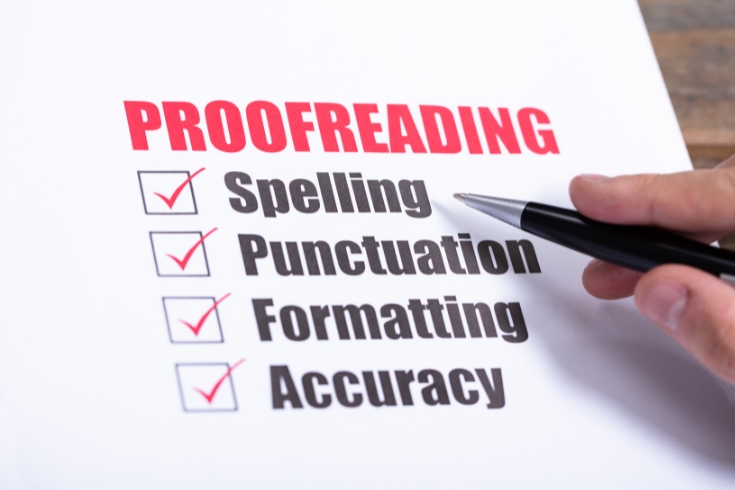Proofreading errors are a common issue that many college students face when writing essays. As the field of freelance writing has grown, it has become an increasingly flexible and attractive career path. However, to succeed in this field, it is essential to develop a strong skillset, including the ability to proofread and avoid common essay writing mistakes.
This article will cover the most frequent grammar errors, structural issues, and other common mistakes found in college essays, as well as the important role that proofreading plays in avoiding these pitfalls. Keep reading to help recognize what mistakes you may be making in order to elevate your material to be noticed.
What Are the Most Common Grammar Mistakes in College Essays?

One of the most common issues in college essays is the incorrect use of grammar. From simple homophones to complex subject-verb agreement, grammar errors can undermine the clarity and professionalism of a student’s writing. By understanding the most common grammatical mistakes, students can better prepare themselves to identify and correct these issues during the proofreading process.
Pay particular attention to the following issues to help keep your work polished and understandable:
- Incorrect use of homophones: Words that sound the same but have different meanings, such as “there/their/they’re,” “to/two/too,” and “it’s/its,” are frequently misused. This can lead to confusion and undermine the overall coherence of the essay.
- For example:
Incorrect: The students are going over there notes before the exam.
Correct: The students are going over their notes before the exam.
- Subject-verb agreement errors: Ensuring that the subject and verb agree in number (singular or plural) is a common challenge, especially with collective nouns or complex sentence structures. Failing to maintain subject-verb agreement can result in awkward or unclear sentences.
- For example:
Incorrect: The team of players were excited about the big game.
Correct: The team of players was excited about the big game.
- Pronoun errors: Proper use of pronouns, including ensuring that the pronoun agrees with its antecedent in number and gender, can be tricky for some writers. Incorrect pronoun usage can create ambiguity and make the essay harder to follow.
- For example:
Incorrect: A student should always do their homework on time.
Correct: A student should always do his or her homework on time.
- Comma splices: This occurs when a comma is used to join two independent clauses without a coordinating conjunction (e.g., “and,” “but,” “or”). Comma splices are a common grammatical error that can lead to run-on sentences and a lack of clarity.
- For example:
Incorrect: The weather was sunny, we decided to go to the beach.
Correct: The weather was sunny, so we decided to go to the beach.
- Apostrophe misuse: Correctly using apostrophes to indicate possession or to show the omission of letters in contractions is a common stumbling block for many writers. Improper apostrophe use can make an essay appear sloppy and unprofessional.
- For example:
Incorrect: The students notebooks were left on the desk.
Correct: The students’ notebooks were left on the desk.
- Dangling modifiers occur when a modifier (usually an introductory phrase) is not clearly connected to the intended subject of the sentence. They can create confusion and ambiguity in the writing.
- For example:
Incorrect: Walking through the park, the birds were singing.
Correct: As I was walking through the park, the birds were singing.
- Incorrect verb tense usage: Maintaining consistent verb tense throughout an essay is important for clarity and coherence. Switching between tenses can be disorienting for the reader and undermine the overall flow of the essay.
- For example:
Incorrect: The researcher analyzes the data and will publish the findings next month.
Correct: The researcher analyzed the data and will publish the findings next month.
- Run-on sentences and sentence fragments: Proper sentence structure, avoiding run-ons, and using complete sentences are crucial for clear and effective communication. Poorly constructed sentences can make an essay difficult to read and understand.
- For example:
Incorrect: I went to the store I bought milk and eggs.
Correct: I went to the store and bought milk and eggs.
- Weak thesis statements: A strong, clear thesis statement is the foundation of a well-structured essay, but many students struggle to craft an effective one. A weak or unclear thesis can leave the reader unsure of the essay’s main argument or purpose.
- For example:
Incorrect: This essay will discuss strategies for effective proofreading.
Correct: Developing effective proofreading strategies is crucial for college students to produce polished, error-free writing.
- Lack of topic focus: A cohesive essay requires staying on topic and ensuring that each paragraph supports the main argument. Straying from the central focus can confuse the reader and undermine the overall effectiveness of the writing.
- For example:
Incorrect: The essay started by discussing the importance of proofreading, but then went on to talk about time management and study habits.
Correct: The essay maintained a clear focus on exploring different proofreading techniques throughout.
- Improper citation of sources: Correctly citing sources, both in-text and in the reference list, is a necessary skill for academic writing. Failure to properly attribute information can lead to issues with plagiarism and undermine the credibility of the essay.
- For example:
Incorrect: According to the article, good proofreading habits are essential for writers.
Correct: According to a study published in the Journal of College Writing, good proofreading habits are essential for writers (Smith, 2020).
What Role Does Proofreading Play in Avoiding Mistakes?
Proofreading is crucial for avoiding mistakes because it allows writers to carefully review their work and catch any errors or inconsistencies before submitting the final essay. Proofreading helps writers ensure that their grammar, punctuation, spelling, and overall structure are correct and polished.
One of the primary benefits of proofreading is that it helps writers identify and correct grammatical errors. By carefully reading through the essay, writers can spot issues such as subject-verb agreement problems, incorrect use of homophones, and pronoun errors. Proofreading also allows writers to ensure that their sentences are properly structured, with no run-on sentences or fragments.
In addition to catching grammatical mistakes, proofreading enables writers to strengthen their thesis statements and maintain a clear, consistent focus throughout the essay. By reviewing the essay, writers can ensure that each paragraph supports the main argument and that the essay flows from the introduction to the conclusion in a logical manner.
Proofreading is also important for ensuring proper citation of sources. Writers can double-check that they have correctly formatted in-text citations and the reference list, which is crucial for avoiding plagiarism and demonstrating their research skills.
Strategies for Effective Proofreading

Proofreading should never be overlooked. All writers, no matter their skill level, are prone to making mistakes in their work – whether they are errors in grammar, punctuation, spelling, or even larger structural issues. For college students in particular, developing effective proofreading strategies is crucial, as poor proofreading can lead to low grades and a diminished academic reputation.
By learning techniques to carefully review their writing, students can ensure their essays are polished, professional, and free of careless errors. Mastering proofreading is not only important for academic success, but it is also a valuable skill that will benefit students throughout their careers.
Read Aloud
Reading the essay aloud can help writers catch mistakes that may have been overlooked when reading silently. The human ear is often better equipped to identify grammatical errors, run-on sentences, and other issues that may be more difficult to spot on the page.
Focus on One Type of Error at a Time
Instead of trying to catch every possible mistake in a single pass, writers can improve their proofreading efficiency by focusing on one type of error at a time. For example, they could first check for subject-verb agreement, then move on to pronoun usage, and so on.
Use Technology Tools
There are a variety of technology tools, such as spelling and grammar checkers, that can assist writers in identifying potential errors. While these tools should not be solely relied upon, they can be a helpful complement to the proofreading process.
Ask for Feedback
Asking a peer, tutor, or professor to review the essay can provide valuable feedback and help writers catch mistakes they may have overlooked. Fresh eyes can often identify issues that the writers themselves have become desensitized to. Hire a professional essay writer to provide an objective, experienced perspective that can identify lingering grammar issues, clarify the thesis statement, and ensure the essay maintains a cohesive focus.
Take Breaks
Proofreading can be mentally taxing, so it’s important for writers to take breaks and come back to the essay with fresh eyes. This can help them better identify errors and inconsistencies that may have been missed during the initial proofreading sessions.
Develop a Proofreading Checklist

Creating a personalized proofreading checklist can help writers ensure that they consistently check for the most common mistakes in their writing. This can be especially helpful for writers who tend to struggle with particular grammar or structural issues.
Conclusion
Proofreading errors can be a significant obstacle for college students when writing essays, but by being aware of the most common mistakes and the importance of proofreading, writers can improve the quality of their work. From grammar and punctuation issues to structural problems and citation errors, a thorough proofreading process can help writers identify and correct a wide range of mistakes. By developing strong proofreading skills, college students can increase their chances of producing high-quality essays that showcase their knowledge, critical thinking, and writing abilities.
<p>The post Common College Essay Mistakes To Avoid first appeared on DAILY WRITING TIPS.</p>
Go to Source
Author: Danielle McLeod